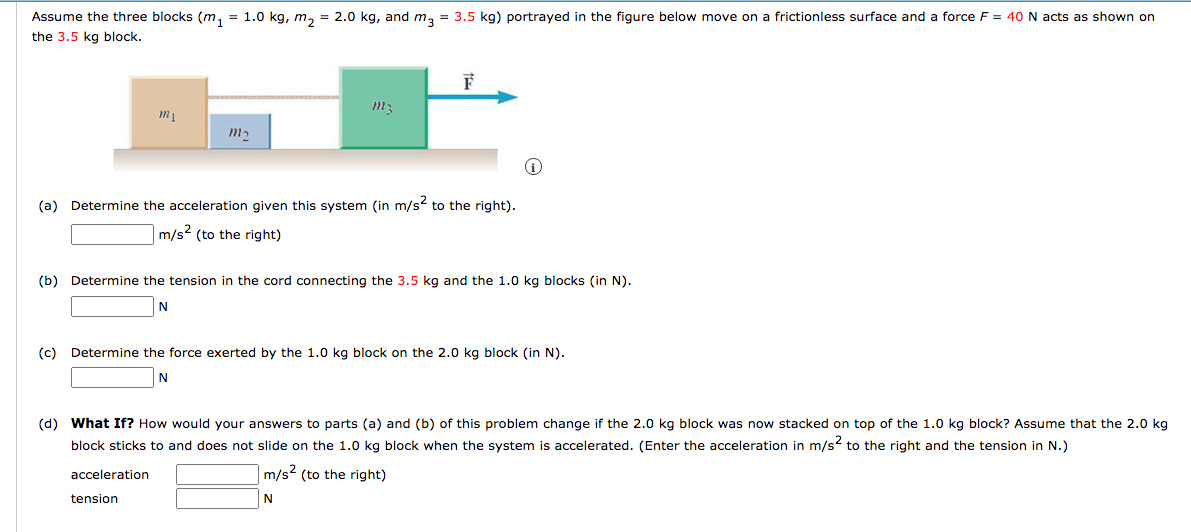Assume the three blocks (m, = 1.0 kg, m, = 2.0 kg, and m, = 3.5 kg) portrayed in the figure below move on a frictionless surface and a force F = 40 N acts as shown on the 3.5 kg block. m2 (a) Determine the acceleration given this system (in m/s to the right). m/s2 (to the right) (b) Determine the tension in the cord connecting the 3.5 kg and the 1.0 kg blocks (in N). (c) Determine the force exerted by the 1.0 kg block on the 2.0 kg block (in N). N
Assume the three blocks (m, = 1.0 kg, m, = 2.0 kg, and m, = 3.5 kg) portrayed in the figure below move on a frictionless surface and a force F = 40 N acts as shown on the 3.5 kg block. m2 (a) Determine the acceleration given this system (in m/s to the right). m/s2 (to the right) (b) Determine the tension in the cord connecting the 3.5 kg and the 1.0 kg blocks (in N). (c) Determine the force exerted by the 1.0 kg block on the 2.0 kg block (in N). N
Physics for Scientists and Engineers
10th Edition
ISBN:9781337553278
Author:Raymond A. Serway, John W. Jewett
Publisher:Raymond A. Serway, John W. Jewett
Chapter3: Vectors
Section: Chapter Questions
Problem 15P: The helicopter view in Fig. P3.15 shows two people pulling on a stubborn mule. The person on the...
Related questions
Question

Transcribed Image Text:Assume the three blocks (m, = 1.0 kg, m, = 2.0 kg, and m, = 3.5 kg) portrayed in the figure below move on a frictionless surface and a force F = 40 N acts as shown on
the 3.5 kg block.
(a) Determine the acceleration given this system (in m/s to the right).
m/s2 (to the right)
(b) Determine the tension in the cord connecting the 3.5 kg and the 1.0 kg blocks (in N).
N
(c) Determine the force exerted by the 1.0 kg block on the 2.0 kg block (in N).
N
(d) What If? How would your answers to parts (a) and (b) of this problem change if the 2.0 kg block was now stacked on top of the 1.0 kg block? Assume that the 2.0 kg
block sticks to and does not slide on the 1.0 kg block when the system is accelerated. (Enter the acceleration in m/s to the right and the tension in N.)
acceleration
m/s2 (to the right)
tension
N
Expert Solution
This question has been solved!
Explore an expertly crafted, step-by-step solution for a thorough understanding of key concepts.
This is a popular solution!
Trending now
This is a popular solution!
Step by step
Solved in 5 steps with 3 images

Knowledge Booster
Learn more about
Need a deep-dive on the concept behind this application? Look no further. Learn more about this topic, physics and related others by exploring similar questions and additional content below.Recommended textbooks for you

Physics for Scientists and Engineers
Physics
ISBN:
9781337553278
Author:
Raymond A. Serway, John W. Jewett
Publisher:
Cengage Learning

Physics for Scientists and Engineers with Modern …
Physics
ISBN:
9781337553292
Author:
Raymond A. Serway, John W. Jewett
Publisher:
Cengage Learning

Principles of Physics: A Calculus-Based Text
Physics
ISBN:
9781133104261
Author:
Raymond A. Serway, John W. Jewett
Publisher:
Cengage Learning

Physics for Scientists and Engineers
Physics
ISBN:
9781337553278
Author:
Raymond A. Serway, John W. Jewett
Publisher:
Cengage Learning

Physics for Scientists and Engineers with Modern …
Physics
ISBN:
9781337553292
Author:
Raymond A. Serway, John W. Jewett
Publisher:
Cengage Learning

Principles of Physics: A Calculus-Based Text
Physics
ISBN:
9781133104261
Author:
Raymond A. Serway, John W. Jewett
Publisher:
Cengage Learning